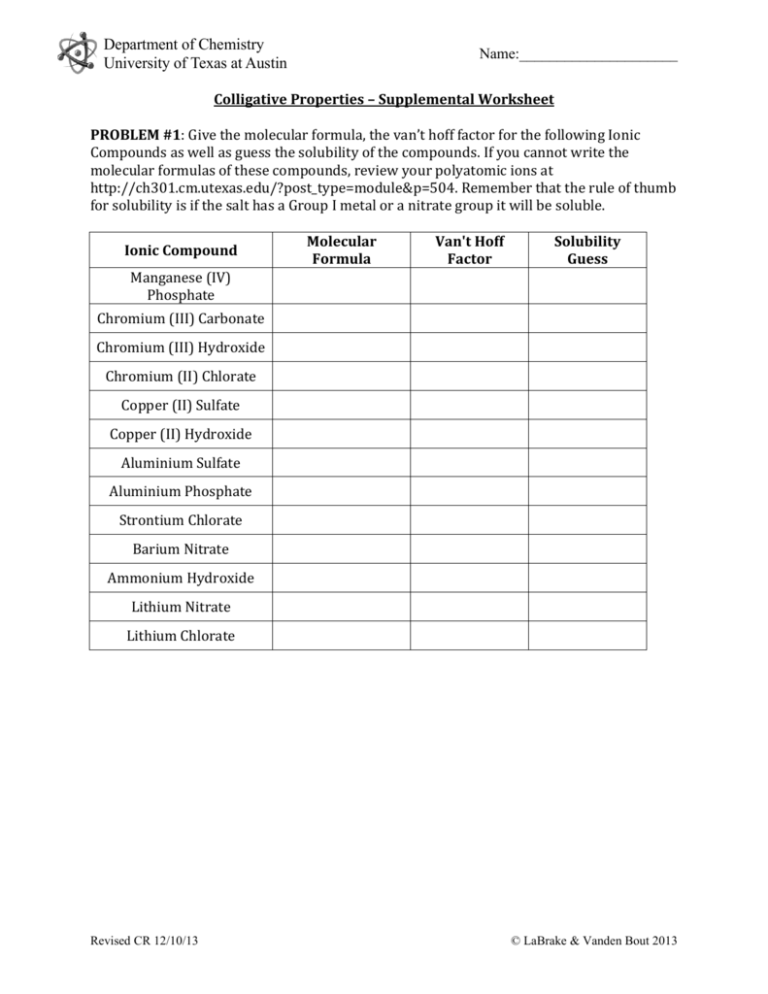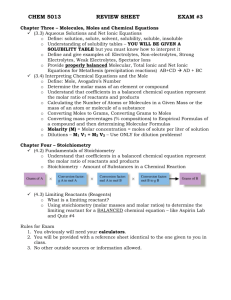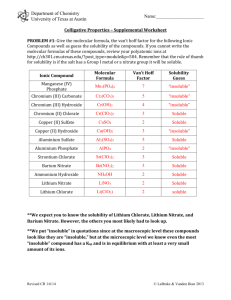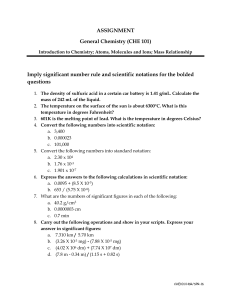Colligative Properties
advertisement

Department of Chemistry University of Texas at Austin Name:_____________________ Colligative Properties – Supplemental Worksheet PROBLEM #1: Give the molecular formula, the van’t hoff factor for the following Ionic Compounds as well as guess the solubility of the compounds. If you cannot write the molecular formulas of these compounds, review your polyatomic ions at http://ch301.cm.utexas.edu/?post_type=module&p=504. Remember that the rule of thumb for solubility is if the salt has a Group I metal or a nitrate group it will be soluble. Ionic Compound Molecular Formula Van't Hoff Factor Solubility Guess Manganese (IV) Phosphate Chromium (III) Carbonate Chromium (III) Hydroxide Chromium (II) Chlorate Copper (II) Sulfate Copper (II) Hydroxide Aluminium Sulfate Aluminium Phosphate Strontium Chlorate Barium Nitrate Ammonium Hydroxide Lithium Nitrate Lithium Chlorate Revised CR 12/10/13 © LaBrake & Vanden Bout 2013 Department of Chemistry University of Texas at Austin Name:_____________________ PROBLEM #2: At a lake in the Rocky Mountains, the partial pressure of oxygen is 0.19 atm. What is the molar concentration of oxygen in the lake at 25 °C? The value of Henry’s Law constant for O2 dissolved in water at 298 K is 4.34*104 atm. Assume the density of the lake is 1 g/ml. STEP-BY-STEP QUESTIONS 1. What equation did we learn in class that has to do with the material in this problem? 2. Is what we are looking for found in this equation? 3. What can we find using this equation and what we have been given? Calculate that value. 4. This value is going to help us find the molar concentration of oxygen. Assume a sample that contains 4.378E-6 moles of oxygen. How many moles of water are in the sample? 5. What is the mass of this sample? 6. What is the volume of this sample? 7. What then is the molar concentration of this sample? Remember the molar concentration is the moles of solute in 1 liter of solution. Revised CR 12/10/13 © LaBrake & Vanden Bout 2013 Department of Chemistry University of Texas at Austin Name:_____________________ PROBLEM #3: Calculate the equilibrium vapor pressure of the 100 mL of 0.1 M lithium sulfate. The density of the solution is 1.15 g/mL) and the vapor pressure of pure water is 25 Torr at room temperature. STEP-BY-STEP QUESTIONS 1. What equation did we learn in class that has to do with the material in this problem? 2. Is what we are looking for found in this equation? 3. Do we have everything we need to solve for the vapor pressure of the solution? If not, what are we missing? 4. What do we need to find the information we are missing? 5. How many moles of lithium sulfate do we have in the solution? What is the equation for lithium sulfate? How much mass does lithium sulfate contribute to the mass of the solution? 6. What is the total weight of the solution? 7. How much of the mass of the solution is due to the water molecules? Revised CR 12/10/13 © LaBrake & Vanden Bout 2013 Department of Chemistry University of Texas at Austin Name:_____________________ 8. How many moles of water molecules are in the solution? 9. What is the solvent molar fraction? 10. Calculate the vapor pressure of the solution. Compare and Contrast Moment What aspects were the same about problem #3 and problem #2? What aspects were different about problem #3 and problem #2? Revised CR 12/10/13 © LaBrake & Vanden Bout 2013 Department of Chemistry University of Texas at Austin Name:_____________________ PROBLEM #4: The addition of 125 mg of caffeine to 100 g of cyclohexane lowered the freezing point by 0.13 k. Calculate the molar mass of caffeine. The K(f) for cyclohexane is 20.1 K*kg*mol-1. STEP-BY-STEP QUESTIONS 1. What equation did we learn in class that has to do with the material in this problem? 2. Is what we are looking for found in this equation? 3. What can we find using this equation? Calculate that value. 4. Can that value help us find the molar mass of caffeine? How? 5. How many moles of caffeine are in the solution? 6. What is the molar mass of caffeine? Remember that the molar mass of a compound is the mass of 1 mole of the compound. Revised CR 12/10/13 © LaBrake & Vanden Bout 2013 Department of Chemistry University of Texas at Austin Name:_____________________ PROBLEM#5: A mysterious ionic compound is soluble in water and dissociates into one anion and one cation in solution. The aqueous solution of this mysterious compound containing 25 g/L develops an osmotic pressure of 0.54 torr at 25°C. Find the approximate molecular weight of this compound. STEP-BY-STEP QUESTIONS 1. What equation did we learn in class that has to do with the material in this problem? 2. Is what we are looking for found in this equation? 3. What can we find using this equation? Calculate that value. 4. Is the above value the molarity of the compound or molarity of ions in solution? 5. Can that value help us find the molecular weight of the compound? How? 6. Calculate the molecular weight of the mysterious compound. Compare and Contrast Moment What aspects were the same about problem #4 and problem #5? What aspects were different about problem #4 and problem #5? Revised CR 12/10/13 © LaBrake & Vanden Bout 2013







